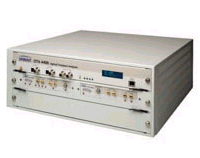Not all 40-Gbit/s testers are created equal, says Spirent; competitors beg to differ
March 25, 2002

ANAHEIM, Calif. -- OFC 2002 -- At last week's Optical Fiber Communication Conference and Exhibit (OFC), Spirent Communications attempted to demonstrate that not all 40-Gbit/s testers are created equal.
Spirent's OTA-4400 looks to be the first tester capable of checking Sonet (Synchronous Optical NETwork) and SDH (Synchronous Digital Hierarchy) protocols at full line rates, while performing bit error rate (BER) and jitter analysis. So far, rivals Agilent Technologies Inc. (NYSE: A), Anritsu Corp., and SHF Communication Technologies AG -- which also offer 40-Gbit/s testers -- can't quite offer the same feature set.
Here's the skinny: Spirent claims the OTA-4400 is the only 40-Gbit/s tester on the market that measures a 40-Gbit/s Sonet stream issued by optical or electrical devices as a single entity, without first breaking up the channel into smaller ones.
Spirent claims a unique design is behind its ability to offer the full-channel testing, including FPGAs (field programmable gate arrays) that incorporate Sonet framing and other key functions in specially designed algorithms.
News of the tester surfaced during the recent CeBIT trade show in Hanover, Germany. But the company waited until OFC to do live demonstrations.
So far, Spirent's claim seems to hold water. Its competitors test 40-Gbit/s streams by demultiplexing them, then analyzing the individual channels in parallel.
At a panel discussion at OFC last week, Larry Desjardin, high-bandwidth program manager for Agilent, acknowledged that his company breaks up the 40-Gbit/s data stream in its ParBERT series unveiled last year (see Testers Forge On to 40 Gigs). SHF has confirmed that its 40-Gbit/s testers demux a 40-Gbit/s stream before analyzing it, although there are plans to migrate to a fully integrated solution at an unspecified date. Anritsu confirms that it too uses the multichannel breakout approach.
Spirent says its ability to analyze the whole 40-Gbit/s stream at once gives it the ability to get a better bead on Sonet activity.
"Higher-level analysis requires information to be in one place," says Nathan Mariels, director of hardware for optical network testing at Spirent.
Not everyone agrees. A spokesperson for SHF, for instance, says there's "no disadvantage" to analyzing multiple channels, because the instrument takes into account that it's working on a single channel. Further, the vendor says it achieves faster measurements by taking multiple channel readings in parallel.
Anritsu isn't ready to break the bank moving to a single-channel solution either. "Customers want a complete solution," says a spokesman. "They're not concerned so much with how that's achieved. You could have squirrels in there if it got the job done." Still, he says Anritsu will consider a single-stream tester if the market wants it. Right now, the company's not convinced they do.
Unfortunately, Spirent can't totally back up its claims because it has yet to add certain capabilities that build on its most compelling feature. While Spirent tests jitter, control overhead problems, and payload errors in the OTA-4400 today, it has yet to add the ability to analyze packet-over-Sonet or even Asynchronous Transfer Mode (ATM) protocols on top of all that.
This combination of features could prove to be groundbreaking for component and systems developers and other customers, since there's no tester on the market today that packs them all into a single box with direct testing of a full 40-Gbit/s channel. The higher-layer protocol analysis is due to be added before the end of the year, Spirent says.
Is that time enough for rivals to catch up?
Time will tell. Spirent maintains that other features of the OTA-4400, besides its single-channel testing of 40-Gbit/s streams, will challenge competitors. "We had a lot of questions asked at OFC about our jitter analysis capabilities," Mariels says. And he says the OTA-4400 is smaller than other gear and easier to set up.
All of this, of course, must pass the market test. And so far, Spirent hasn't furnished any information about customer adoption of the box. Onlookers differ on the readiness of the 40-Gbit/s market (see 40 Gbit/s: Ready for Prime Time?). It will be interesting to see whether offerings from Spirent and other test gear vendors boosts momentum.
And whether that squirrel idea's got legs. — Mary Jander, Senior Editor, Light Reading
— Mary Jander, Senior Editor, Light Reading
http://www.lightreading.com
You May Also Like








